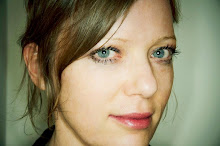Ingo Maurer’s oversize lightbulb “Lucellino”
(all photos by the author for Hyperallergic unless
otherwise noted)
DALLAS — Aurora illuminated the Dallas Arts District last Friday, featuring 90 site-specific light and sound installations covering 19 blocks of downtown from 7 pm until midnight. An estimated 30,000 people gathered and wandered through the city, taking in the transformation that molded buildings, illuminated cathedrals, lit hidden spaces, and made concrete, glass, and steel pulse.
Upon entering the city of Dallas two days earlier, one of the first things I had noticed was the intensity of the birdsong. It was louder than the cars passing by as I walked down a four-lane street during sunset, in rush-hour traffic. Later that night, walking back to my hotel after dinner, I looked up to see an incredibly bright, full moon. These moments of magic set the stage for my experience of Aurora.
The block party, live music, food trucks, pop-up bars, lounges, and 1,050 lanterns all opened and lit up at 6 pm, but the real transformation of the city began an hour later. In a very theatrical display, Mayor Mike Rawlings plugged in the chord of an oversize lightbulb with wings, part of sculpture by Ingo Maurer that was placed directly between the Wyly Theatre and the Dallas Opera House. Each artist or team of artists had walkie-talkies and had been poised for the signal, so at that moment, they activated their pieces. Suddenly, the Dallas Arts District was converted into a brilliantly expansive light and sound exhibition.
The theme of this year’s Aurora was “Light of Convergence,” which, according to the press release, “illuminates the dichotomy between awareness of the individual and the greater whole.” The theme revolved around ideas of how technology can enable communal consciousness and increase creativity and social awareness, but also have a darker side. I was able to catch up briefly with one of the cofounders, Joshua King (the others are Veletta Forsythe Lill and Shane Pennington). He explained, “It’s about bringing people together under creative circumstances, artists supporting other artists, the contrast of new media and technology-based art within city centers and an immersive experience of ideas.”
The evening showcased contemporary artists from North Texas alongside others from all over the world. One of the featured works was a piece by Max Deancalled “The Robotic Chair,” in which Dean’s generic wooden chair falls apart and then magically reassembles itself, facilitated by a custom-made robot. I was very excited to see the work, but apparently so was a lot of the crowd. I visited the site three times throughout the night, and the lines were so long, I never made it in.
Norwegian artist Anne Katrine Senstad (whom I recently wrote about for Hyperallergic) showed her piece “Colour Synesthesia, Variation IV,” a 60-minute, abstract, color-based loop projected that transformed the altar of the Cathedral Shrine of the Virgin of Guadalupe. Senstad’s work focuses on perception, space, and the sensorial, and her projections bring a new narrative to their locations’ histories, memories, and identities. Senstad told me, “There’s a dialogue that goes beyond words yet is a space of ‘the word,’ bringing light and ambience into a space charged with faith and human belief.”
Aurora cofounder Shane Pennington exhibited a massive LED light installation called “Points of Life,” a specially designed stage curtain created for the Dallas City Performance Hall. Jazz singer Kally Price performed live behind the curtain, along with accordionist Dan Cantrell and bassist Daniel Fabricant. The curtain combined with the tones of the jazz created a shifting feeling, from calm and light to haunting.
3_search, “Blueprints and Perspectives”
(courtesy Martin Gabor)
3_Search, a collaboration between curator Leo Kuelbs, artist John Ensor Parker, and animation and mapping collective Glowing Bulbs, brought the exterior of the Wyly Theater alive through a massive projection mapping piece called “Blueprints and Perspectives.”
Having seen similar work of theirs before, I found this piece much more experiential and less narrative. The concept seemed driven by the interior structure of the stage and the mechanics of the theater, as well as the exterior form. “Beginning with an exploration of the physical architecture of the Wyly,” Parker explained, “we then delve into the psychology of the individual and their connectivities through social structures and the fabric of the universe.”
Aurora is a young festival, only its third year. But not many cities in the US are taking on a project of this size for one night only of pure light and sound installations. The temporary nature of the art added a theatrical and magical feeling to the experience. I look forward to seeing how the event will flourish in the next few years.
Aurora 2013 took place on Friday, October 18, from 7 pm to midnight, throughout the Dallas Arts District.



